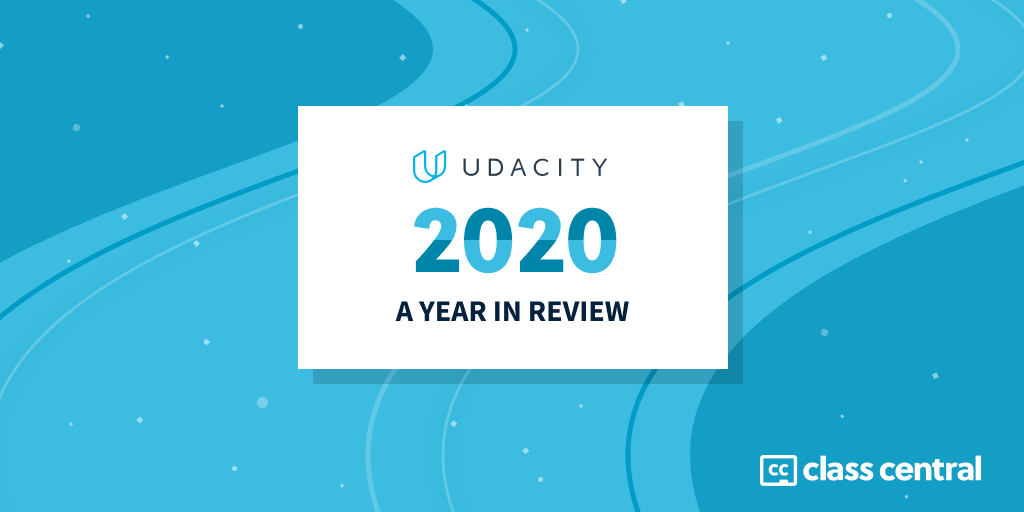Udacity’s 2020: Year in Review
After two years of restructuring, Udacity claims it has reached profitability by pivoting to corporate training.
In 2019, to turn the company around after a lackluster 2018, Udacity continued its restructuring. This involved increasing Nanodegree prices, expediting their rollout, laying off staff, and appointing a new CEO.
In 2020, aided by the pandemic and by a pivot to corporate education, Udacity says it has reached profitability and has raised $75M in debt, 5 years after its last funding round. The pivot was foreshadowed by changes in the company’s consumer business. These included shuttering Udacity China, moving further away from academia, and using aggressive retention tactics.
For Class Central’s complete analysis of Udacity’s 2020, keep reading. For previous years’ analyses, follow the links:
- Udacity’s 2019: Year in Review
- Udacity’s 2018: Year in Review
- Udacity’s 2017: Year in Review
- Udacity’s 2016: Year in Review
By the Numbers
| 2017 | 2018 | 2019 | 2020 | |
| Nanodegrees | 22 | 35 | 40 | 59 |
| Graduates | 18K | 65K | 100K | 150K |
| Revenue | 70M | 90M | NA | NA |
| Employees | 500 | 350 | 300 | 400 |
Highlights
Enterprise & Government Pivot
In November 2020, Udacity CEO Gabe Dalporto opened up about the company’s pivot toward enterprise and government customers. Formerly a small fraction of Udacity’s portfolio of clients, this segment will soon represent 80% of the company’s business, according to Dalporto.

More specifically, Udacity’s newfound focus is on provisioning Nanodegrees to, and creating tailored learning content for, enterprises and governments looking for ways to upskill their workforce. While avoiding specifics, Udacity has shared that its portfolio of clients includes:
- The world’s leading pharmaceutical company.
- Five of the world’s top seven aerospace companies.
- Three of the four branches of the US Department of Defense.
According to Udacity, the company’s marked pivot, compounded by the pandemic-driven surge of interest in e-learning, has allowed them to reach profitability, following two years of restructuring. Udacity also revealed it had secured a $75M debt facility (a loan of sorts) to further expand its business market, raising questions about the future of its consumer market.
Pandemic Response Shenanigans
In March 2020, as the world was locking down due to the pandemic, providers began offering free e-learning resources to attract housebound learners. Udacity, in particular, began offering month-long Nanodegree free trials with a “cancel anytime” policy. Or so they said.
Indeed, learners — including myself — soon discovered that cancelling these free trials wasn’t as easy as expected. Instead of taking two clicks, like they used to, cancellations now required chatting with, calling, or emailing a Udacity advisor and navigating through their retention script.
So @udacity lures you with a free month offer and then makes it impossible to cancel. To cancel you have to call a number which asks you to email support. The support replies to ask you to call or chat. On the chat someone quizzes you why are you canceling! @dhh @DoNotPayLaw
— Madhav Jha (@madhavjha) April 22, 2020
Despite drawing complaints on social platforms such as Twitter or Reddit, these retention tactics seem to have persisted into late 2020, months past the end of the pandemic free trials. This could impact Udacity’s hard-earned reputation with learners. But now that their main clients are businesses and governments, it might be a price they’re willing to pay.
Udacity China Shuts Down
Besides its main domain, Udacity has an ICP-licensed subdomain (cn.udacity.com), which it used to operate in China since 2016, with the support of a team of local employees.

In an exclusive report, Class Central revealed that Udacity China had stopped accepting Nanodegree enrollments in April 2020 and was in the process of laying off its local staff, in preparation for a complete shutdown in late 2020.
The decision, which was likely motivated by the need to cut costs, also aligns well with Udacity’s pivot toward corporate education. Udacity China’s operation involved localizing Nanodegrees to acquire a local consumer market. But Udacity’s new focus is on businesses rather than individuals.
Top Online Degree Leaves Udacity
Co-founded by three Stanford affiliates, Udacity’s origins are deeply rooted in academia. Early on, however, the provider began emphasizing industry skills over academic subjects.
2020 heralded a new milestone in this regard. In August, Georgia Tech revealed that it wouldn’t offer its Online Master of Science in Computer Science (OMSCS) via Udacity anymore. Instead, the online degree, which has over 10K students and costs about $7K, would be offered through Georgia Tech’s LMS.

OMSCS was perhaps the last notable vestige of Udacity’s academic roots. Launched jointly by Udacity and Georgia Tech in 2014, OMSCS has grown to become the largest master’s degree program in the US. While existing OMSCS courses will remain part of Udacity’s catalog for the foreseeable future, all new courses will be launched directly on Georgia Tech’s LMS.
Offering
Nanodegrees
One of the measures taken by Udacity as part of its restructuring plan was to accelerate Nanodegree rollouts, in a bid to more rapidly find the next blockbuster Nanodegree.
In 2019, Udacity launched 14 Nanodegrees, 5 more than in 2018. This trend has continued in 2020: this year, Udacity launched 17 Nanodegrees and 2 Executive Programs:
- Intro to Machine Learning with TensorFlow Nanodegree
- AI for Business Leaders Executive Program
- Product Manager Nanodegree
- Intel Edge AI for IoT Developers Nanodegree
- SQL Nanodegree
- AI for Healthcare Nanodegree
- AWS Cloud Architect Nanodegree
- Machine Learning Engineer for Microsoft Azure Nanodegree
- Growth Product Manager Nanodegree
- Introduction to Cybersecurity Nanodegree
- Intermediate JavaScript Nanodegree
- Data Product Manager Nanodegree
- DevOps Engineer for Microsoft Azure Nanodegree
- Data Science for Business Leaders Executive Program
- Agile Software Development Nanodegree
- RPA Developer Nanodegree
- Developer for Microsoft Azure Nanodegree
- Android Kotlin Developer Nanodegree
- Hybrid Cloud Engineer Nanodegree
Free Courses
In 2020, Udacity launched 5 free courses, down from 7 in 2019 and 35 in 2018. This drop emphasizes Udacity’s growing focus on paid content, and it further distances the company from its origins as one of the world’s main providers of open online courses.
| 2013 | 2014 | 2015 | 2016 | 2017 | 2018 | 2019 | 2020 |
| 12 | 31 | 64 | 49 | 34 | 35 | 7 | 5 |
Graduations
In an email to Class Central, Udacity states it has reached 150K Nanodegree graduates in 2020, up from 100K in 2019. Although encouraging, this metric must be considered in light of the COVID-19 pandemic, which has caused a surge of interest in online education.
Class Central too saw a drastic influx of visitors. Of all the people that have ever used Class Central since its inception nine years ago, 40% (18M learners) did so for the first time in 2020.
Scholarships
In 2020, Udacity announced five scholarship programs.
Scholarships give learners a chance to earn a free spot in a Nanodegree. They typically focus on a particular subject, involve an industry partner, and may lead to different Nanodegrees.
| Scholarship | Partner | Nanodegrees Funded |
| Hybrid Cloud | Nutanix | 500 |
| Technology | Bertelsmann | 1600 |
| Machine Learning | AWS | 325 |
| Machine Learning | Microsoft Azure | 300 |
| Pledge to America’s Workers | Udacity | 1000 |







